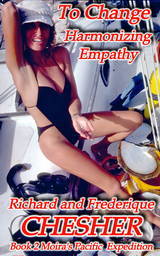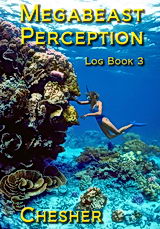The Love Bug
Once and awhile comes a love like none other. Two beings made for
each other. Each and every thing they do fits together in perfect harmony. Totally
supportive in every way.
With a love like that, anything is possible.
How many different kinds of relationships exist between beings? Let me count the ways.
Predation leaps to mind. One life form devouring another. All animals do it, developing some of life's most fantastic adaptations.
Disease and Parasitism, little monsters preying on their hosts from the inside out, eating a little bit more each day. A very popular relationship, hugely common on our planet, refined into some really bizarre relationships with complex life cycles involving multiple hosts and complete changes in body, form and function.
Inquillinism.
Pearl fish have a very kinky relationship with sea cucumbers. How about sliding your pointy tail into the anus of a sea cucumber and slithering inside to hide out during the day? Inquillinism, means living inside another creature without harm.
Most of the time.
If the pearl fish gets hungry it might just nibble on the sea cucumber's innards.
Commensalism.
Getting together for mutual benefit. Like this tiny shrimp that lives in the branches of a feather starfish, or crinoid. It helps keep the tentacles clear of debries and parasites while gaining protection and nibbles in the process. There are a vast multitude of commensal relationships, like cute little neon gobies that wiggle-dance to attract big fish of many different species. The big fish open their mouths, the gobies swim in and eat the parasites from the gills of the big fish. The gobies get a meal of parasites, the big fish get cleaned. Although it is clear, watching this, that the cleaning sometimes hurts the big fish, they wince but don't bite.
Herbivores nibble away at the plants of the world. They usually don't kill the plants and often actually help maintain ecological balance in many ways. Including being prey for predators. Some species of fish farm plants, carefully cultivating them, improving their lot in life. Surely farming is commensalism.
Mutualism
Mutualism brings two creatures, like clownfish and sea anemones, together.
This is a nice relationship. Right out of one of those "how to achieve
happiness with your partner" books.
Mutualism is everywhere you look on coral reefs. One creature, like the clownfish, will feed and protect the other in exchange for some kind of protection. If danger threatens the fish it will race into the tentacles and vanish amid hundreds of stinging tentacles. The clownfish actually trains the anemone not to sting it. Each clownfish introduces itself to its partner over a period of months when the fish is very small. A special protein in the mucous of the scales identifies the particular fish.
Most coral reef fish have a mutual relationship with the corals. They hide in the branches of the corals if danger threatens and in return the fishy waste products rain down on the coral's little upturned faces providing much needed phosphates and nitrates.
Symbiosis.
Ahh, Symbiosis; the mover and shaker of evolution. Symbiosis is the big special love where two beings come together in perfect harmony. They become one, living together, changing together, staying together for all time. This is different from any other kind of relationship. Love like this does not happen often. In a world full of predation, disease, parasitism, mutualism, commensalism, and stoic, uncaring loneliness, misunderstandings are more common than total understanding. But when it does happen it changes the whole world.
The Love Bugs
It must have been instant, full, unrequited, perfect love the first time the beings came together. A touch, a kind of sudden recognition, a wonder, awe, and zowie. Forever. Absolutely forever. For two billion years they have evolved together. All the myriad forms and styles of beings of Earth are children of that perfect love.
The love bugs. There are, naturally, two of them. One is called chloroplast, the other mitochondrion. Chloroplast is the little being that makes plants green and converts sunshine, carbon dioxide and water into sugars and oxygen. Mitochondrion is the little being that takes sugars and oxygen and changes them to carbon dioxide and ATP, the fuel for life.
The Greatest Love Story on Earth
Once upon a time, billions of years ago, the world was full of thousands of different kinds of bacteria and they fought continuously with each other, inventing highly sophisticated molecular weapons to attack and defend the other.
One strain of bacteria developed a system to manufacture a deadly poisonous gas, Oxygen. They released this into the sea, killing all of their enemies. Another strain of bacteria discovered a way to detoxify oxygen by combining it with carbon to produce carbon dioxide and a high octane fuel called ATP. The creature that invented this defense became the Mitochondrion love bug.
One day, on the edge of a great continent that no longer exists, a great battleship of a bacterium captured and devoured a mitochondrion love bug. The defenses of the love bug prevented the giant from digesting it, but the bigger bacterium built a force field made of complex lipid molecules, imprisoning, but not harming the love bug. The love bug loved it. Food was abundant, it had everything it wanted. It was so fat and happy it divided into two and these into two more. The big cell was also ecstatic with the relationship as it could easily utilize the ATP for it's own a high octane energy. But even better, the mitochondrion bug destroyed the highly poisonous gas, oxygen! To get more ATP, the bacterium had only to provide sugars. And there was plenty of sugar in the cyanophyte bacteria. And the planet's oceans had become covered with thick mats of them.
Now the big bacterium, inhabited by many love bugs, became a "cell" or organization of individuals. It went right into the masses of blue green algae that coated Earth's seas, without fear of the poison gas, oxygen. The cell fed on cyanophyte bacteria and divided again and again, populating the oceans with itself. The cyanophytes developed many other defenses but the great mats were gradually consumed and the seas became clear. One of the cyanophyte defenses was a much better defended oxygen manufacturing nodule called a chloroplast.
The Chloroplast
Perhaps a million years or so later, one of the issues of the predatory cell engulfed the second love bug, the chloroplast. This creature, like the mitochondrion, could not be digested and the cell placed it in a force field prison and would not release it. The chloroplast produced lots of oxygen and sugar. The mitochondrion love bug took oxygen, sugar and water and transformed it into more energy and carbon dioxide. The chloroplast took sunlight, carbon dioxide, and water and turned it into sugars. The two love bugs were all that the big cell needed, other than access to water and some essential minerals that were common in Sea. Instead of chasing all over the oceans hunting, the big cell could simply float about in the surface waters and relax while the chloroplast and the mitochondrion did their harmonious best to make everyone happy. The big cell didn't have to do much more than protect the two of them from harm, and it designed bigger and better force fields made from a remarkably tough molecule called cellulose to fend off attacks by other predators. This union worked well and the cells evolved into all the plants on Earth.
The big cells with only one love bug - the mitochondria - evolved into all the animals on Earth, keeping up with the constant improvement in plant defense by inventing new ways to harvest them.
The love bugs are so perfect that they have not changed very much in the billions of years the cells have cherished them. The cells have evolved into all the wonderful display of life on Earth, but the love bugs remain happily engaged in their relationship.
Love bugs reproduce by dividing. The cells don't make them. They divide and divide again in perfect harmony and balance with the cells. This means that the love bugs in every form of life on earth are the original issue love bugs. I mean, the love bugs in every cell on Earth have never died. Each one is at least two, perhaps three billion years old.
Love Bug Mark II, Zooxanthellae
There is another love bug. A long snake-like bacteria that is a powerful swimmer. It is called a flagellum or sometimes a cilia. At some point in time, many different kinds of cells began using flagella or cilia as whip-like propellers to speed them through the water. One of these cells, called Gymnodinium, became a second level love bug, one in great demand by some 650 or so reef building corals, 6 species of giant clams, a scattering of gorgonians and a flatworm.
Corals hunt the love bugs just after they form into microscopic swimming planulae larvae. When they find the Gymnodinium, they absorb it (or the Gymnodinium infects the larvae, nobody knows who initiates the relationship). The Gymnodinium drops the flagellum and becomes a rounded cyst. The cysts are called zooxanthellae. About 8000 could fit on the period at the end of this sentence. Special amoeboid coral cells grab hold of the zooxanthellae and carry them through the quickly growing coral polyp. They shove the cysts between other coral cells, just under the outer skin cells where they can get the most light. The zooxanthellae divide and divide again, forming a thick garden of brightly colored cells crammed between the coral cells. Eventually, the zooxanthellae outweigh the coral cells by about three to one. All of the rich colors of tropical corals come from the zooxanthellae - the coral cells are transparent.
If the coral is put into a dark room, it rejects the zooxanthellae, spewing them out into the sea water with long strands of mucous. The coral continues to live and, if replaced in the light again, it can become repopulated by zooxanthellae.
The coral does not (at least not normally) eat the zooxanthellae in its system. The coral polyps use their tentacles to catch other kinds of small creatures from the sea and they capture pellets of fecal material dropped by fish schooling over the reefs. The captured food and fecal material is rich in phosphates and nitrates. These fertilize the zooxanthellae.
The coral cells produce carbon dioxide, nitrate and phosphate as waste as do all animal cells. The zooxanthellae, nestled in the coral tissue, take these waste materials and use them as food. Using sunlight, they convert the coral wastes into carbohydrates and oxygen. Both they and the coral cells use these to energize the complicated job of rearranging the elements of sea into their form, to maintain vigilance, move and reproduce as needed for survival.
Relationships depend on different viewpoints
Zooxanthellae as parasites
A century ago, biologists classified corals with plants. When they discovered the relationship of coral and zooxanthellae they thought of the zooxanthellae as parasites. Even today, biologists talk about corals becoming infected by zooxanthellae. This was a perfectly reasonable view. Looked at from the standpoint of the zooxanthellae, the coral was a host. They entered the host and multiplied, filling every available space. The coral provided food and shelter. The growth pattern of the coral was modified by the influence of the zooxanthellae to maximize sunlight exposure for the benefit of the parasites. If things got tough, the zooxanthellae could escape into the sea.
Zooxanthellae as cultured plants
Other scientists thought the corals farmed the zooxanthellae. Seen from the perspective of the coral, the zooxanthellae were slaves. The coral cells captured and arranged them in their tissues. The coral cells obviously farmed the zooxanthellae to provide themselves with food and oxygen. The method is so successful a coral colony produces more food and oxygen than it can use by itself. These are released into the sea water and help support the other reef creatures around them.
Zooxanthellae as partners
Then a third viewpoint was proposed to satisfy both schools of thought. The coral cells and the zooxanthellae both benefited from the association, a phenomenon already known in lichens. This mutual association in plants was called symbiosis (living together) and the concept seemed to fit well with the coral-zooxanthellae relationship. A great deal has been written about corals and zooxanthellae from this viewpoint and everyone agrees this is the best way to look at the association. But there is another viewpoint.
Corals and Zooxanthellae as one concept
At some point in the distant past, coral cells and zooxanthellae learned to live together. This association changed them forever in basic ways. Over the millions of years they have lived together, the corals learned ways to behave to increase their survival in particular circumstances. Some became flattened, some massive, rounded colonies, some grew big polyps, some grew polyps so small they look hardly different than the skin connecting them. Some became blue, some brown, some green, some yellow, some orange.
Each new behavior pattern was etched forever in the genetic memories of the individual lines of coral behavior, never to be forgotten. Today, there are about 650 species of reef building corals, each one living in special niches on the coral reef. The coral colony we see on the reef today is the result of millions of years of evolution. Throughout all those years,
- the way the coral grew,
- the behavioral network of the polyps,
- the intercommunications between cells,
included both coral and zooxanthellae.
The reef building corals we see today would never have evolved without that association. The corals and the zooxanthellae are not separate beings, they are a single intercommunication reacting with the surrounding environment in a unified effort to survive.
This view looks at the coral colony as the web of intercommunications extending between the zooxanthellae, the coral cells, and the other creatures of the whole coral reef ecosystem.
While it is true we can remove the zooxanthellae and the corals can live without them for awhile, this is only a temporary interruption in the web of communication creating the existence of the coral. On the coral reef, at night, the loss of zooxanthellae produces a drastic drop in oxygen levels and if the association is not renewed quickly, the corals and many other reef creatures die. This is, in fact, a major problem for today's coral reefs. In the late 1990's corals began ejecting their zooxanthellae in response to elevated sea temperatures. This "coral bleaching" epidemic resulted in massive die-offs of the coral reefs of the Pacific and Indian Oceans.
From the viewpoint of the fields of intercommunication creating the coral colony and the coral reefs, the zooxanthellae and coral cells are a single concept, intercommunicating in perfect harmony.
Symbiosis is still a useful term, but with a focus on the relationship, the intercommunications, and not the "individuals".
Not forgetting that the "individuals" involved, coral cells and zooxanthellae, are themselves intercommunications of the earlier appearance of the most perfect love affair on Earth.



